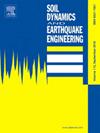Modified S-transform based high-resolution dispersion imaging method for multi-channel surface wave data
IF 4.2
2区 工程技术
Q1 ENGINEERING, GEOLOGICAL
引用次数: 0
Abstract
High-resolution dispersive energy imaging is crucial in the multi-channel analysis of surface waves (MASW) for accurately predicting the near-surface shear wave velocity profile. Existing wavefield transformation methods such as time intercept-phase slowness (τ-p) transform, frequency-wavenumber (f-k) transform, phase-shift method, and the high-resolution linear Radon transform (HRLRT) often face challenges in low signal-to-noise-ratio (SNR) environments. This study proposes a modified S-transform-based high-resolution wavefield transformation method to unambiguously image the surface wave's dispersion spectrum, even for low SNR. Following the time-frequency analysis of the raw shot-gather, the method splits the pseudo-seismogram for individual frequency. After that, slant slices along different surface wave group velocities are obtained and processed using the HRLRT. Finally, the transformed spectrum for all available group velocities is converted to the dispersion spectrum in the frequency-phase velocity - domain. The effectiveness of the proposed technique is demonstrated using two synthetic datasets and three field records. Dispersion spectra produced by the proposed method are compared with those obtained with the Slant - (SFK) transform and HRLRT. The results demonstrate that the proposed method performs better than the existing high-resolution dispersion imaging methods, especially in low SNR scenarios. It effectively processes noiseless and noisy records, producing accurate, high-resolution, mode-separated dispersion spectra even under challenging conditions.
求助全文
约1分钟内获得全文
求助全文
来源期刊

Soil Dynamics and Earthquake Engineering
工程技术-地球科学综合
CiteScore
7.50
自引率
15.00%
发文量
446
审稿时长
8 months
期刊介绍:
The journal aims to encourage and enhance the role of mechanics and other disciplines as they relate to earthquake engineering by providing opportunities for the publication of the work of applied mathematicians, engineers and other applied scientists involved in solving problems closely related to the field of earthquake engineering and geotechnical earthquake engineering.
Emphasis is placed on new concepts and techniques, but case histories will also be published if they enhance the presentation and understanding of new technical concepts.
 求助内容:
求助内容: 应助结果提醒方式:
应助结果提醒方式:


